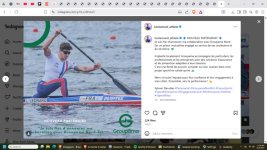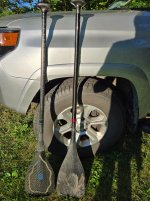Allan, thank you for taking the time to put some numbers on the paddle discussion, there are lots of folks sharing paddle experience and favourite type/length etc and shows we all have some interest.
I am really enjoying this discussion, but I have a few things that sort of give me pause for thinking.
Paddles are generally built to a set of specifications, when you buy a paddle you look for specifications that meet your use criteria. Initially, most sizing methods are trying to determine the shaft length and then blade area/shape .... that works for the specific user.
When you use the paddle length, as a paddle descriptor, personally, I feel it tends to confuse the issue IMO. As an example ... when I say I went from my 62" BeaverTail to a 55" Sugar Islet Bent Shaft and it was more comfortable and I found it easier to paddle with less fatigue. While it is a true statement, it really doesn't give the reader any information about the mechanics associated with your opinion.
The reality is that both paddles have a 32" shaft (which is my sizing) , so overall length difference is in the blade(s) not the shaft, the Beavertail has an area of 148 sq. inches versus 124 in the Islet, that is a significant difference in the water being pushed around . The statement is basically true to how I feel about these two , if I was using my solo. The seat is quite low and the longer length of the BT makes clearing the stroke more difficult, the shorter blade, in this situation, makes it easier to lift the paddle clear of the water ... making the Islet an easier stroke. The BT is moving a lot more water with each stroke so cadence comes into play as well, if you try and keep the same stroke rate with these 2 paddles the observation is quite predictable.
Swapping the above to the Otter Tail gives pretty much the same result, it is 62" with a 32" shaft and 124 square inch blade, meaning it pushes the same water as the Islet, but that long blade doesn't work as well in the lower seating position.
This is a long winded way of saying that with out the additional information included in a post, there is little way for the reader to learn from the posters experience, because the pertinent info isn't included.
Allan, I think using the BPM as a governor is a decent attempt at keeping it a level playing field. I was looking at the photos and that straight shaft does look to be some larger than the other 2, any chance you could overlap the blades and see if that is correct or an optical illusion?
Brian
I am really enjoying this discussion, but I have a few things that sort of give me pause for thinking.
Paddles are generally built to a set of specifications, when you buy a paddle you look for specifications that meet your use criteria. Initially, most sizing methods are trying to determine the shaft length and then blade area/shape .... that works for the specific user.
When you use the paddle length, as a paddle descriptor, personally, I feel it tends to confuse the issue IMO. As an example ... when I say I went from my 62" BeaverTail to a 55" Sugar Islet Bent Shaft and it was more comfortable and I found it easier to paddle with less fatigue. While it is a true statement, it really doesn't give the reader any information about the mechanics associated with your opinion.
The reality is that both paddles have a 32" shaft (which is my sizing) , so overall length difference is in the blade(s) not the shaft, the Beavertail has an area of 148 sq. inches versus 124 in the Islet, that is a significant difference in the water being pushed around . The statement is basically true to how I feel about these two , if I was using my solo. The seat is quite low and the longer length of the BT makes clearing the stroke more difficult, the shorter blade, in this situation, makes it easier to lift the paddle clear of the water ... making the Islet an easier stroke. The BT is moving a lot more water with each stroke so cadence comes into play as well, if you try and keep the same stroke rate with these 2 paddles the observation is quite predictable.
Swapping the above to the Otter Tail gives pretty much the same result, it is 62" with a 32" shaft and 124 square inch blade, meaning it pushes the same water as the Islet, but that long blade doesn't work as well in the lower seating position.
This is a long winded way of saying that with out the additional information included in a post, there is little way for the reader to learn from the posters experience, because the pertinent info isn't included.
Allan, I think using the BPM as a governor is a decent attempt at keeping it a level playing field. I was looking at the photos and that straight shaft does look to be some larger than the other 2, any chance you could overlap the blades and see if that is correct or an optical illusion?
Brian


